Who hasn’t had a hard time at some point with trying to keep their plants watered appropriately?
If you regularly forget to water or you keep giving your plants too darn much, get yourself a soil moisture meter. These garden tools take the guesswork out of watering for happier plants.
Learn more below.

We link to vendors to help you find relevant products. If you buy from one of our links, we may earn a commission.
I’ve killed more plants than I care to admit by failing to give them the right amount of water. Can you relate?
It seems like such a straightforward gardening task, but it can be frustratingly difficult to master.
I’ve overwatered succulents, and I’ve let my fiddle leaf fig get so dry that it started tossing its leaves to the ground in protest.
Then, one day I saw a funny-looking thing sticking out of a friend’s bed of lettuce, and I discovered the world of soil moisture meters. These handy tools help take the guesswork out of watering.
Sure, you can stick your finger in the soil, but this is more of an art than a science, an imprecise way of figuring out what your plants need. And with this method, you can only tell what’s happening in the top few inches.
A moisture meter can tell you exactly how moist the soil is, and not just in the top few inches, but up to a foot down – or more!
Plus, you can keep your gloves on, and avoid getting your fingers dirty with one of these on hand.
Thanks to my hygrometer, I’m not killing plants because of bad watering practices anymore.
Want to know how to put these handy garden tools to work for you? Here’s what we’ll cover:
What You’ll Learn
What Is a Soil Moisture Meter?
Soil moisture meters are small hygrometers, or tools that let you measure average moisture levels, that you can insert into the earth to determine how moist it is.
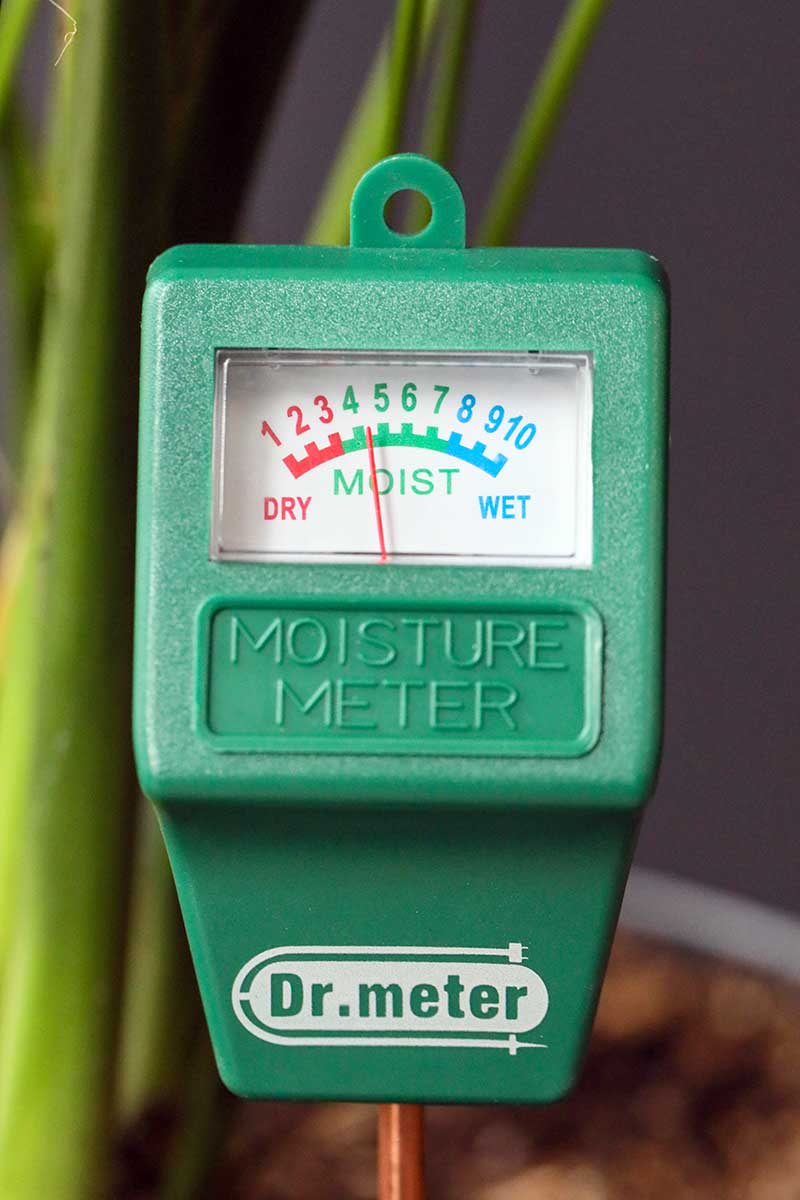
This provides a consistent analysis of how much water is in your growing medium, letting you know when it’s time to water, or if you should hold off for now.
These tools typically give you a reading within 60 seconds, and they’re simple to use.
Most of them have a little window display that shows the moisture level on a scale, typically ranging from dry to wet.
Some have a numerical scale, a color-coded face, or both, to make reading the moisture level easy. And most don’t even require batteries to give you your reading!

The one that I rely on is made by Dr. Meter. You can purchase one of these at many nurseries, or via Amazon.
Find more models in our supplemental guide: “9 of the Best Soil Moisture Meters for Your Garden.”
Some meters only measure water, but others are available that also read pH and light levels.
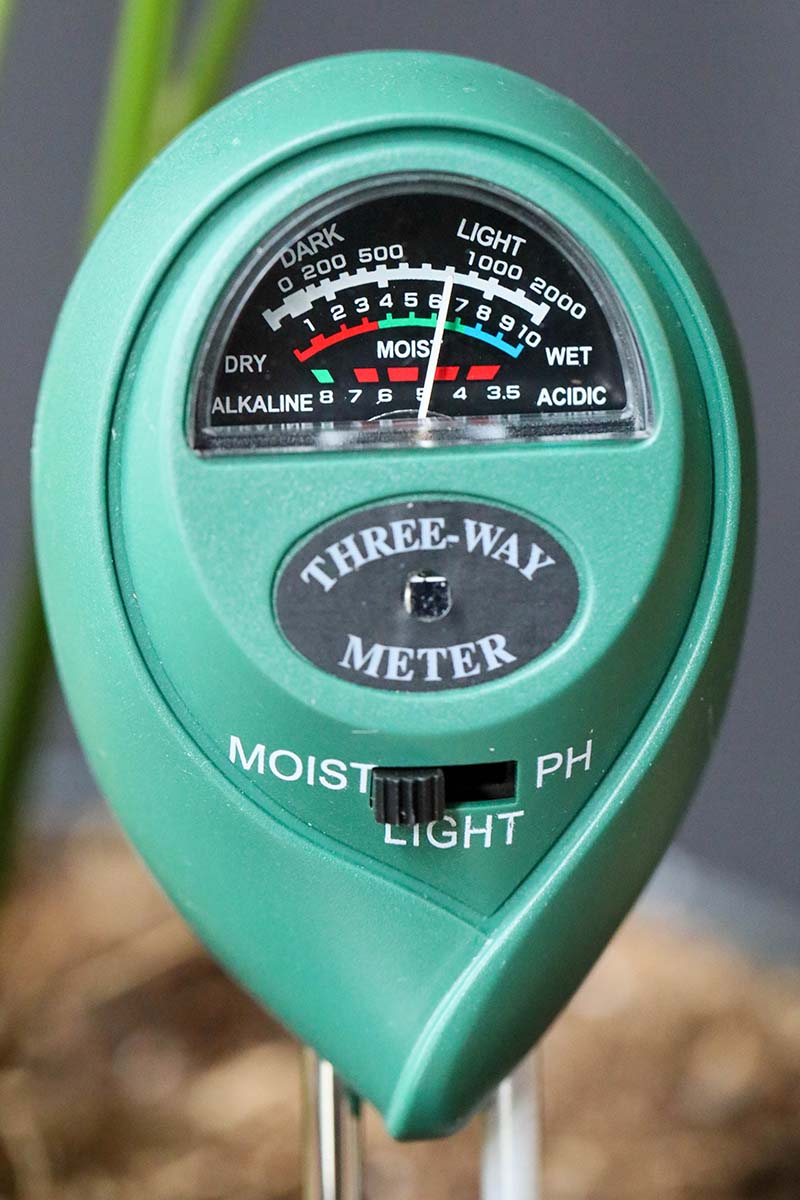
If you like the 3-way style that provides all of these readings at once, you can pick up one at Arbico Organics.
Are these tools magic? Nope. They measure moisture by detecting electrical currents in the soil. The more moisture is available, the higher the currents are.
How to Use One
To put this handy tool to work, gently insert the probe end into the soil so that it is buried four-fifths of the way deep. Don’t force it. If you meet resistance, try another spot.

If you’re using one with two probes, be sure to insert it vertically.

Wait 60 seconds, then check the moisture level reading in the display window.
Compare the reading to the needs of your particular plant.
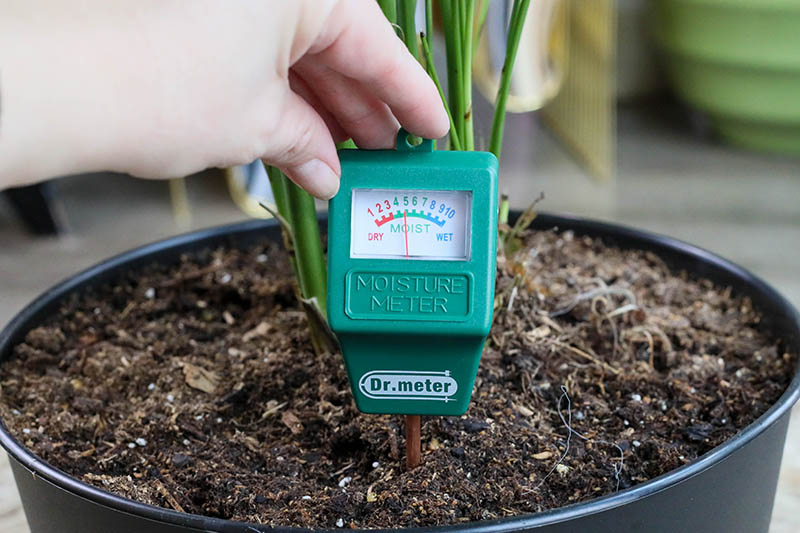
For instance, cacti and succulents like to be on the moist end of dry when they are freshly watered.
Cannas and Siberian irises prefer to be on the wet end of the spectrum. And some plants prefer to dry out quite a bit between waterings while others prefer consistently moist soil.
In other words, when you check your meter, don’t assume that a result putting your soil moisture in the mid-range is ideal.
You want drier soil for some plants and wetter for others.
If you check your cactus and it shows as a three – or on the moist end of dry – it probably doesn’t need water. But if you are checking an orchid and it shows as a three on the scale, it needs a drink stat.
After watering, let the plant sit for a minute and check the results again.
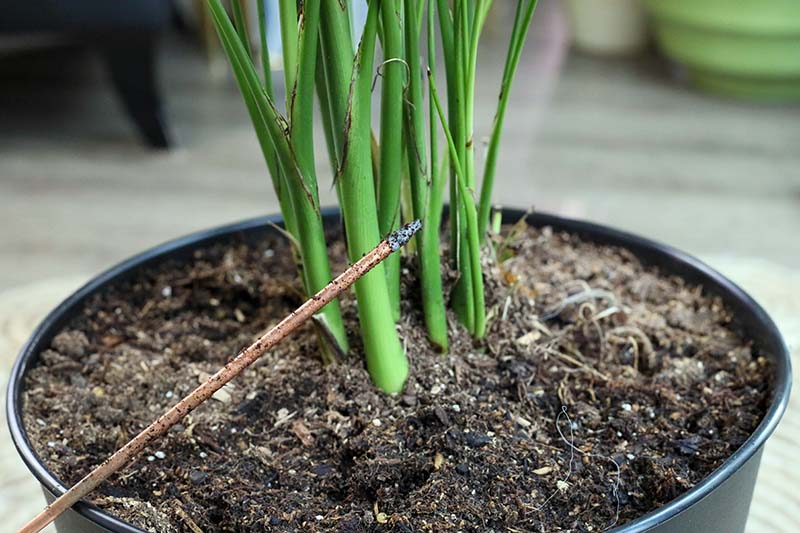
Once you’re done, remove the probe, wipe it clean, and store it.
Don’t leave it in the soil because the probe will rapidly degrade.
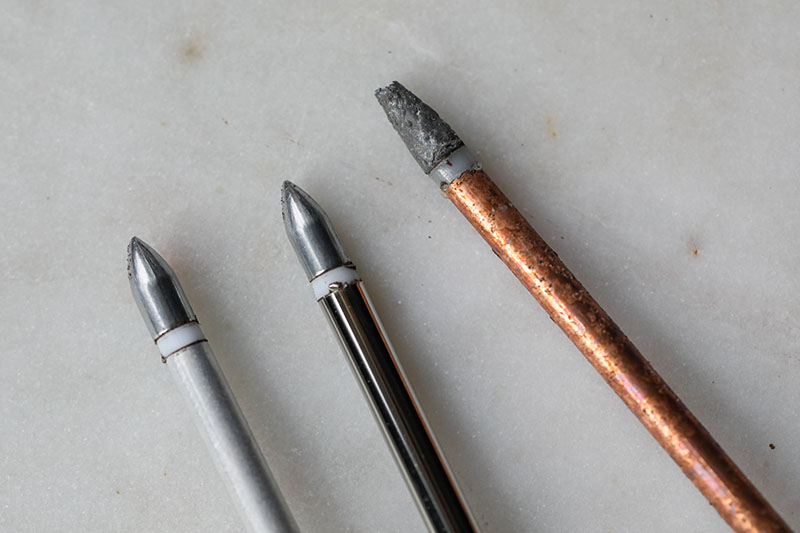
See these two probes? One was left in the soil for a month (okay, maybe more like three months. What? I got busy), while the other has been removed consistently after use and cleaned.
Troubleshooting Tips
While these are pretty straightforward tools, they are still subject to problems. Sometimes a probe fails to provide a reading or the needle may bounce around like a rabbit after downing a pot of coffee.
If you put the probe in and the needle doesn’t move, remove it and wipe the probe clean. DON’T stick it in a container of water to see if it’s working. The probe won’t work in water and is intended for use in soil only.
Instead, soak some soil thoroughly with water to do a test. It should be completely saturated so that it drips water if you pick up a sample. Then, stick the probe in. If it still doesn’t read, it might be faulty.
If the needle is bouncing around and doesn’t settle, it might be touching some metal or a rock under the soil. Pull it out and sink it in another spot.
Remember, you should never leave the meter in the soil for days or weeks on end. This can ruin the probe.
I also recommend checking the soil with your finger now and then to confirm that the meter is working. Don’t solely rely on the hygrometer.
If your plant looks like it’s wilting, you can stick a finger in the soil as a point of comparison. The meter may say moist but the soil is actually dry, if it isn’t working properly.
A soil moisture meter may malfunction if you have a high level of salt in your soil. This can happen if you water from the bottom of a container or if you use a fertilizer with salts in it.
If your soil is saline, you will get an incorrectly high moisture reading, which is why it’s important to physically check with your finger if you suspect the reading is wrong.
Take the Guesswork Out of Watering
Hygrometers are incredibly handy. What’s easier than just sticking something in the soil and knowing within a minute whether your plant is dying for a drink, or needs time to dry out?
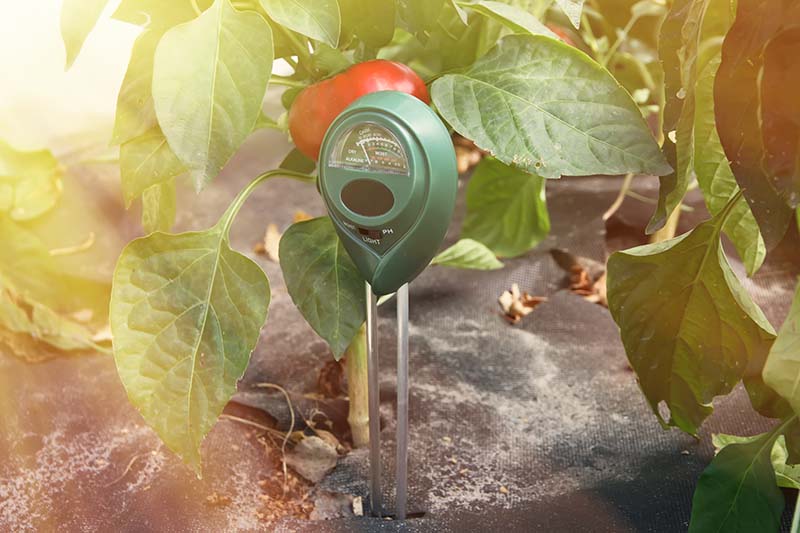
If you’re wondering which moisture meter works best, we have a roundup of the top models to help you out.
Was this article useful for you? If so, you might want to visit some of our other tool guides next to help make gardening easier:
- Maintaining Your Garden Hand Tools
- How to Extend the Life of a Garden Hose
- 13 Must-Have Tools for Gardeners
Photos by Kristine Lofgren © Ask the Experts, LLC. ALL RIGHTS RESERVED. See our TOS for more details. Product photos via Arbico Organics and Dr Meter. Uncredited photos: Shutterstock.


Thank you for sharing your knowledge and the gentle reminder that common sense should prevail because equipment may malfunction from time to time. I am on my fifth lavender plant. I think I’ve over-watered the last 4. With this one, I’m buying a meter. I’m sure I will have better results with number 5 and a meter. Aloha!
This tool is very helpful. Marijuana is a delicate plant to work with. While with use it shows an identifiable accurate reading.
I have had 7 peace lilies and have killed every one of them. I have a probe and still seem to be achieving the same results.
We have a whole collection of guides to growing peace lilies, filled with tips and suggestions. I hope these are helpful!
Moisture meters aren’t for everyone- they have their benefits, but I personally prefer to rely on other indicators using my own senses to determine when it’s time to water plants.
Finally getting one of these; thanks for the tips. It would have been especially helpful if you’d linked to a chart of recommended readings for common crops, as otherwise the tool doesn’t produce any actionable information.
but how do you know what kind of moisture level the plant is supposed to have? do i need to google each plant i have and see what kind of moisture it needs?
Hi Tracy, the short answer is: yes. You need to do a web search or check on the nursery tag for each plant to determine how much moisture it needs. Sadly, there’s no quick shortcut. I know that there are some apps out there like Planta that will tell you what your plant needs and reminds you when to water.
thank you so much for replying! of course i wish there was a quick shortcut but oh well. i will try to just keep them alive however i can. but your answer is very helpful and i appreciate it!
Here’s a list that was on the back of my meter. Hopefully this picture posts and you can actually read it!
Hi Candace, thanks so much for sharing! That’s helpful to have.